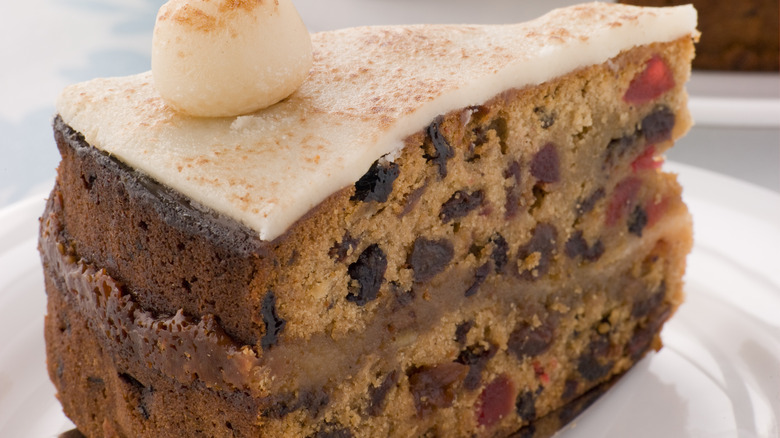What Makes A Japanese Fruitcake Different From The Classic?
When you hear the term "Japanese fruitcake," the first thing that comes to mind is probably some fluffier, sweeter, and more whimsical permutation of the classic fruitcake, perhaps made with castella cake and frosted with shu cream, more or less in the vein of how Japanese cheesecakes compare to the classic New York kind. You might even think it would resemble the Japanese Christmas cake, a soft strawberry sponge cake that's been inexplicably tied to a holiday usually celebrated with much richer and decadent desserts in America. But above all, you're probably going to be astonished to discover that Japanese fruitcake is about the farthest thing from what you might have imagined at first blush.
In fact, it's not even Japanese or very fruity at all. The reality of a Japanese fruitcake is actually a Southern holiday delicacy that's more along the lines of a classic American layer cake than anything else. With cinnamon-spiced cake layers separated by citrusy fruit filling, the Japanese fruitcake is a much lighter and potentially more appetizing alternative to the dense and somewhat maligned fruitcake as we know it. If you're looking for a conversation starter and a sweet cake to serve during the holidays — in addition to not being keen on resorting to alternative recipes just to make a fruitcake palatable — then the Japanese fruitcake is definitely your best bet to shake things up this year.
What is the Japanese fruitcake?
Considering the vast array of American-exclusive forms of foreign cuisine developed over the years — looking at you, California roll — the idea that something called Japanese fruitcake is an entirely American invention isn't all that outlandish in theory. However, a closer look at the typical ingredient list highlights just how peculiar of a misnomer it is. Where American inventions like California rolls and the so-called "Chinese food" you'd find at American Chinese restaurants have clear influences from the original cuisine they're modeled after, Japanese fruitcake doesn't even pretend to involve any ingredient or cooking method that's remotely East Asian by any stretch of the imagination.
While individual recipes may vary, the basic components of a Japanese fruitcake consist of a light cake layer that's primarily flavored with butter and vanilla, a dark cake layer that's made by adding warming spices like cinnamon and nutmeg to the light layer batter, and a jam-like fruit filling most often made with citrus-based fruits and coconut. The only way it resembles the classic fruitcake is via the raisins that are often included in the dark cake layer alongside the warming spices. Overall, it seems like a much lighter and sweeter cake to end holiday meals with, though that lightness inevitably comes with the trade-off of not being nearly as sturdy or long-lasting as a classic fruitcake.
Why is it called the Japanese fruitcake?
The mystery of why such a quintessentially American-seeming cake is called the Japanese fruitcake remains largely unsolved, with some plausible theories but no reputably confirmable answers. This enigma cake has a surprisingly long history that further complicates any attempt to pin down its exact origins: One of the earliest publications of Japanese fruitcake as a recipe goes back to a 1914 cookbook by Kate Brew Vaughn, "Culinary Echoes from Dixie." However, with an assortment of crystallized fruits and no layering in the baking process, Vaughn's Japanese fruitcake more resembles classic fruitcake than the Southern cake as it's known today.
Most attempts to map out the invention of layered Japanese fruitcake will be traced back to the recipe published in Henrietta Stanley Dull's 1928 cookbook, "Southern Cooking." While there is an earlier published iteration of the layered Japanese fruitcake — contributed by one Mrs. Geo through the Los Angeles Times in 1926, according to FoodTimeline.org — it seems likely that Dull's recipe was the one to popularize the layered version in the South due to her renown as a chef and food critic at the time.
However, it's worth noting that Mrs. Geo's recipe includes raisins like most modern Japanese fruitcake recipes do, while Dull's iteration does not. Without concrete evidence, this discrepancy is hard to explain, but it does seem to suggest that Japanese fruitcake might have established itself as a general regionally-known recipe well before Dull put it to pen and paper.
How did the Japanese fruitcake start?
As for why there was ever a "Japanese" fruitcake to begin with, no one can say for certain. The most likely answer points to the sensationalism of Japanese-inspired things in America at the time. Kickstarted by Japan's opening to foreign trade in 1853, the phenomenon known as Japonisme was quite prevalent in many parts of American arts and culture throughout the late 1800s to early 1900s, coinciding almost perfectly with the first popular publications of Japanese fruitcake.
Food author Anne Byrn, on page 246 of her book "American Cake," states that Kate Brew Vaughn found that the audience at her cooking shows were much more intrigued by her version of Japanese fruitcake when she recounted a "story about receiving the recipe from a Japanese chef." Apparently, Japanese-style cakes became very trendy then due to the wave of Japonisme, and it seems very likely that Japanese fruitcakes only became "Japanese" to follow along with public fascination.
Then again, the major caveat to this theory is that there technically is an even earlier published iteration of Japanese fruitcake from 1822, long before the "Japan craze" really took hold of America. Strangely, this extremely early recipe from the book "What's Cookin'?" is baked in two layers and resembles modern Japanese fruitcake more than the 1914 recipe by Vaughn. With so many inconsistencies and quirks surrounding the history of Japanese fruitcake, it may very well be that we'll never know why or how it branched from classic fruitcake with such a strange misnomer to begin with.



